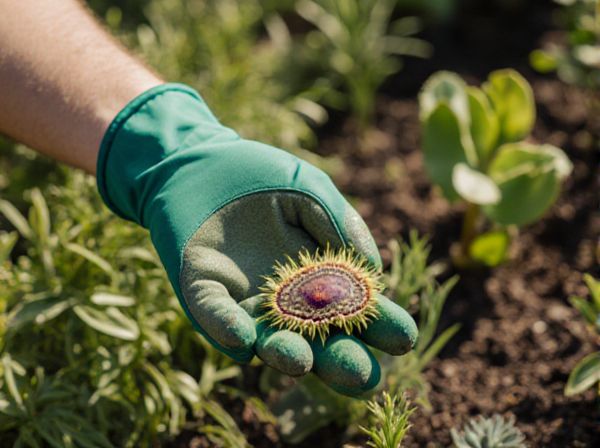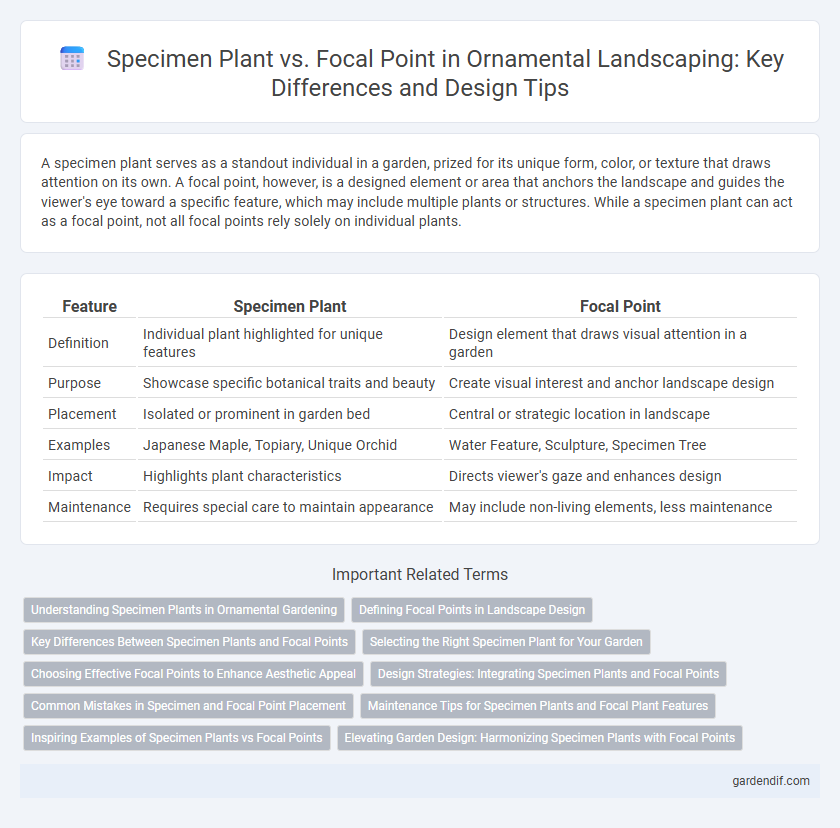
Specimen plant vs Focal point Illustration
A specimen plant serves as a standout individual in a garden, prized for its unique form, color, or texture that draws attention on its own. A focal point, however, is a designed element or area that anchors the landscape and guides the viewer's eye toward a specific feature, which may include multiple plants or structures. While a specimen plant can act as a focal point, not all focal points rely solely on individual plants.
Table of Comparison
| Feature | Specimen Plant | Focal Point |
|---|---|---|
| Definition | Individual plant highlighted for unique features | Design element that draws visual attention in a garden |
| Purpose | Showcase specific botanical traits and beauty | Create visual interest and anchor landscape design |
| Placement | Isolated or prominent in garden bed | Central or strategic location in landscape |
| Examples | Japanese Maple, Topiary, Unique Orchid | Water Feature, Sculpture, Specimen Tree |
| Impact | Highlights plant characteristics | Directs viewer's gaze and enhances design |
| Maintenance | Requires special care to maintain appearance | May include non-living elements, less maintenance |
Understanding Specimen Plants in Ornamental Gardening
Specimen plants are individual specimens chosen for their unique form, color, or texture, creating a distinct visual interest in ornamental gardening. Unlike focal points that draw immediate and dramatic attention, specimen plants subtly enhance garden design through their standalone beauty and seasonal changes. Their strategic placement highlights specific garden areas, providing year-round appeal and structural diversity.
Defining Focal Points in Landscape Design
A focal point in landscape design is a strategically placed element that draws immediate attention and creates visual interest, guiding the viewer's eye across the garden. Unlike specimen plants, which stand out due to their unique characteristics or rarity, focal points often combine various features like statues, water elements, or architectural forms to anchor the space. Effective focal points enhance spatial dynamics and establish a cohesive theme, ensuring the landscape is engaging and harmonious.
Key Differences Between Specimen Plants and Focal Points
Specimen plants serve as individual, standout botanical elements highlighting unique features with distinct forms, colors, or textures, while focal points encompass broader landscape or garden design features designed to draw overall visual attention. Specimen plants are primarily natural elements, such as a singular, striking tree or shrub, whereas focal points can include man-made objects like sculptures, water features, or garden structures. The key difference lies in specimen plants acting as botanical showpieces, whereas focal points function as intentional design anchors directing the viewer's gaze through the garden composition.
Selecting the Right Specimen Plant for Your Garden
Selecting the right specimen plant for your garden involves choosing a unique, visually striking species that enhances the landscape's aesthetic appeal and serves as a natural focal point. The specimen plant should exhibit exceptional features such as vibrant foliage, unusual form, or distinctive flowers that draw attention and create visual interest. Proper placement and maintenance ensure the specimen plant complements other garden elements while standing out as the centerpiece of the design.
Choosing Effective Focal Points to Enhance Aesthetic Appeal
A specimen plant serves as a singular showcase, highlighting unique characteristics such as striking foliage, vibrant flowers, or an unusual form, making it a natural focal point in landscape design. Choosing effective focal points involves selecting plants with distinct visual interest that draw the eye and create a sense of balance and harmony within the garden. Incorporating specimen plants as focal points enhances aesthetic appeal by providing structure, contrast, and a captivating centerpiece that anchors the overall design.
Design Strategies: Integrating Specimen Plants and Focal Points
Specimen plants serve as standout elements in landscape design, showcasing unique form, texture, or color to captivate visual interest. Focal points, often created through structural features or contrasting plantings, guide the viewer's eye and anchor the overall composition. Integrating specimen plants as focal points enhances design cohesion by merging botanical distinctiveness with intentional spatial emphasis.
Common Mistakes in Specimen and Focal Point Placement
Placing specimen plants too close to one another can diminish their individual visual impact, while improper scaling often leads to a lack of balance in the landscape design. Using multiple focal points within a single view creates confusion and detracts from the intended hierarchy, undermining the garden's cohesion. Avoiding these common errors ensures a harmonious arrangement that highlights key ornamental features effectively.
Maintenance Tips for Specimen Plants and Focal Plant Features
Specimen plants require targeted maintenance such as regular pruning, adequate watering, and soil nutrition management to highlight their unique features and ensure healthy growth. Focal plants demand consistent care strategies that enhance their visual impact, including pest control and strategic placement to maximize aesthetic appeal. Both types benefit from seasonal adjustments in care routines to maintain their ornamental value and prominence in garden design.
Inspiring Examples of Specimen Plants vs Focal Points
Specimen plants serve as standout botanical marvels like the vibrant Japanese Maple or the sculptural Agave, capturing attention through unique form and color. Focal points, such as a decorative urn or a water feature framed by boxwood hedges, create structured visual anchors within garden designs. Gardens featuring specimen plants combined with focal points, like a towering Magnolia paired with a rustic stone bench, inspire dynamic landscapes that emphasize both natural beauty and intentional design.
Elevating Garden Design: Harmonizing Specimen Plants with Focal Points
Specimen plants, characterized by their unique form, texture, or color, serve as living sculptures that elevate garden design through their distinct presence. Focal points strategically direct visual interest, creating harmony by enhancing the specimen plant's impact within the landscape. Integrating specimen plants with well-placed focal points amplifies aesthetic appeal and balances the overall garden composition.
Specimen plant vs Focal point Infographic

 gardendif.com
gardendif.com